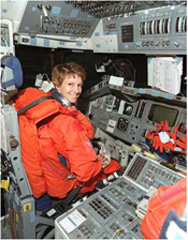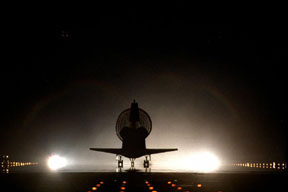Click on image for full size
Courtesy of NASA
Columbia Set to Launch on July 20, 1999 (updated)
News story originally written on July 16, 1999
Space Shuttle Columbia was scheduled to launch on July 20, 1999, but was postponed at the last second. With six seconds left before launch, the mission was haulted due to faulty equipment. The mission has been rescheduled for July 22, 1999, between 12:28 and 1:14 am EDT.
Five astronauts, led by Air Force Col. Eileen Collins, will haul the new Chandra X Observatory into space aboard the Space Shuttle Columbia. This will be the 95th shuttle mission to date. At one time, the future of the launch was in question.
This will be the first time a shuttle has been commanded by a woman. She may be new at commanding, but Collins will be making her third trip into space. Accompanying her is rookie pilot, Capt. Jeff Ashby, Air Force Lt. Col. Catherine Coleman, Steve Hawley and French Air Force Col. Michel Tognini. Collins has a lot of confidence in her young crew.
"This crew is ready to fly," Collins said.
The Chandra X Observatory is the newest tool scientists have for researching the deepest areas of the universe. The $1.5 billion telescope will be more powerful than the Hubble Telescope. Plans involve using the telescope for at least the next ten years. Even the crew is excited about this powerful machine.
On the way to the launch site, pilot Jeff Ashby said,"We launched from Houston this morning and climbed to 41,000 feet. We were cruising along in a very dark sky, but one filled with stars. As we cruised for about an hour under the stars, I couldn't help but think to myself about the kinds of things and wonders were out there for us to learn, the things in our universe that we don't know about yet. I couldn't help but feel very privileged to be a part of the team that's going to put Chandra up there help unlock some of those secrets."















